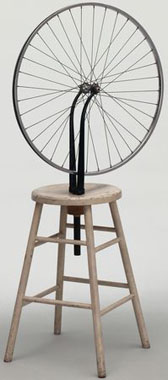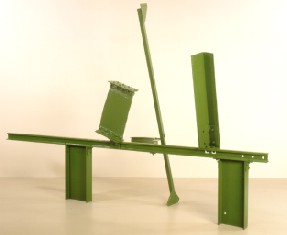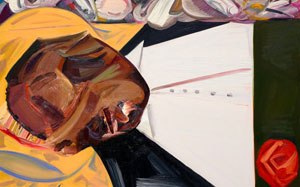You Call That Art!
John Haberin New York City
Stanley Cavell and the Shock of the New
Why is that art? When it comes to art today, does it still make sense to ask? With Andy Warhol helping to ring in the new year at the Whitney, is it essential?
If they seem tired questions, that is part of why they are so hard to answer. It is also why they offer an avenue into art now. Is the problem that too few wealthy players make the rules—or that too many these days claim to speak for art? Has art found a new space between the avant-garde and mass entertainment, or has it given in to the worst of both? It may help to ask first whether art can still break whatever rules remain. I want do so by way of an influential philosopher, Stanley Cavell. 
Philosophy and public consequences
You call that art! The outcry dogged art for well over a century. It made the Salon des Refusés of 1863 and the Armory Show of 1913 a scandal, even as they introduced Impressionism to Paris and Modernism to New York. And art as the locus of controversy and confrontation is not going away. In just the last year or so, protests threatened to cripple the 2017 Whitney Biennial and Chinese art at the Guggenheim. With hostility to funding for the arts under Donald J. Trump, the replay of a scandalous video by David Wojnarowicz at the Whitney now seems all too contemporary—and then there is always Andy Warhol.
Nor is it a question just for philistines and conservatives. A photographer friend often dismisses work as just not art, while taking the time to look. It can hardly be otherwise, when a definition for art eludes critics, philosophers, artists, and audiences to this day. It does so more than ever, in fact, thanks to art's very success. Painting is no longer dead, but then it seems more and more that anything goes, from realism to abstraction. The more art keeps coming, the harder it is to pin down.
Museum attendance is soaring, even as museum expansions cripple budgets. The sheer number of galleries and attendance at openings would have astonished some of the same dealers not all that long ago, even as others keep closing or choose instead to work behind the scenes. Art, it seems, can neither be dying nor healthy—or is it both? A philosophical inquiry may have public consequences. But can philosophers still ask it? I want to approach the puzzle through two essays by Stanley Cavell.
Cavell himself has been making news, thanks, alas, to his death in 2018. A follower and interpreter of Ludwig Wittgenstein and J. L. Austin, he was the most prominent ordinary-language philosopher—the kind that gets at questions by asking what they mean in plain speech. As he put it in the title essay of his first book, Must We Mean What We Say? And both essays on art appeared in that book in 1969. "Music Decomposed" raised the question with which I began almost in passing, in assessing the state of music at the time. "A Matter of Meaning" then replied to critics for whom the question marked him as a philistine, too.
That might seem impossible. Cavell's knowledge and interests made him an important critic of Shakespeare and film as well as music and philosophy. Surely anyone who also wrote a book about classic screwball comedies knew that more than just museum pieces can be art. He could drop references to Modernism's scandals with the best of them. He reminds his critics that the debut of The Rite of Spring, by Igor Stravinsky, ended in a riot.
Not that they needed reminding. Monroe Beardsley wrote the book on the philosophy of art for a generation—a textbook at that. He and Joseph Margolis served as presidents of the American Society for Aesthetics as well. What then, was the controversy all about? Rereading the essays after some thirty years, I found myself wondering whether their controversies and questions are still relevant. Just to ask, it turns out, means also asking just what has changed in the fifty years since publication.
Living on borderlines
Cavell raised the question in discussing an Austrian-American composer, Ernst Krenek. Comparing Krenek's forays into atonal music with random procedures in the work of John Cage, he asked why either one counts as art. Beardsley and Margolis tore into this as close-minded and dismissive. Cavell replied that they misunderstood. Rather than denigrating the music, he meant only that one cannot appreciate Cage unless one sees the question at the heart of his work. Krenek, in turn, does not challenge the nature of art, given his eclecticism and acceptance of modern music—and one fails to hear his work if one does not understand that, too.
 Unless one acknowledges music in all its specificity, Cavell argues, one is left with circular reasoning and useless generalizations. Beardsley accepts a definition of art expansive enough to accommodate whatever is needed, while Margolis labels the work at hand "borderline cases." For both, it makes no sense to ask whether the music counts as art—or, if one prefers, as music. (Cavell notes that it is hard to say which is at stake.) Yet here, too, they miss the point. One has to understand the music to know whether a definition needs broadening—and whether the work is on the border. Elsewhere, Cavell sees affinities between ordinary-language philosophy and the deconstruction of Jacques Derrida, who wrote "Living on: Border Lines," and Cavell embraces the marginal with equal facility.
Unless one acknowledges music in all its specificity, Cavell argues, one is left with circular reasoning and useless generalizations. Beardsley accepts a definition of art expansive enough to accommodate whatever is needed, while Margolis labels the work at hand "borderline cases." For both, it makes no sense to ask whether the music counts as art—or, if one prefers, as music. (Cavell notes that it is hard to say which is at stake.) Yet here, too, they miss the point. One has to understand the music to know whether a definition needs broadening—and whether the work is on the border. Elsewhere, Cavell sees affinities between ordinary-language philosophy and the deconstruction of Jacques Derrida, who wrote "Living on: Border Lines," and Cavell embraces the marginal with equal facility.
He is no happier with other ways to settle the questions once and for all. One can claim that new art makes explicit what art was all along, like the formalism of Clement Greenberg—or one can claim that new art changes things just by existing. The first claim misses how much art does change things, while the second makes the change all too easy. He continues with an example from the visual arts, Anthony Caro. Where older sculptors molded, like Auguste Rodin, or carved, like Constantin Brancusi, Caro simply puts his beams in place and, worse, then paints them red. Knowing full well the criteria for art, he knowingly violates them.
Cavell is running through established definitions of art, and he is not persuaded. Terry Barrett does much the same in 2008 in opening a splendid textbook on contemporary art and philosophy, Why Is That Art? An honorific definition, Barrett explains, identifies art with quality, much like my photographer friend, while an open definition gives up on looking for essentials, like Marcel Duchamp in displaying a bicycle wheel or a urinal. Institutional or classificatory definitions try to list what matters at a given moment—based on past art or, for Arthur C. Danto, the art world. Caro brushes them all aside, as mere excuses. In the process, Cavell insists, he accepts discomfort with his own work as art.
What, though, if all parties here have it right? Perhaps Beardsley, Margolis, and Cavell are just talking past one another. Of course Cage is an American composer, and of course Caro is an English sculptor. How could anyone believe otherwise? If not, what are they doing in performance and on display for so many admirers—and, if not, then what are they? Conversely, how could anyone deny that some work, but only some work, dares one to accept it? (For Cavell, Pop Art with its greater nod to imagery does not.)
Maybe, too, Cavell is right that it is all just a misunderstanding, and he should know. He writes in the ordinary language that he praises, but he does not make reading easy. His mind takes him where it will, so that his essay on definitions becomes halfway through an essay in defense of the artist's intention, in opposition to New Criticism (and so that the title, "A Matter of Meaning It," makes some sense after all). His reading in the same volume of Endgame, by Samuel Beckett, places a character, Hamm, in relation to Noah's son and Hamlet. And then he has to digress to loaded readings of Genesis and Hamlet to justify the move. Even Beckett, with his self-reflective theater, and Shakespeare, with his play within a play, stop short of Cavell's hall of mirrors.
From shock to wonder
Then again, what if all parties here are wrong? Beardsley and Margolis really do want tidier work within a tidier field for esthetics. Cage and Caro do not. Cavell, conversely, may want questions to persist long after no one is asking—and he, too, for all his disdain of what art was like all along, may be generalizing groundlessly from the art he loves to eternal truths. He may be failing to give outrage at art its history. He may also have failed to predict its future.
 He recalls past shocks, but he treats them as the condition of modernity, not distinct events with an aftermath. If Cage could challenge the nature of music in a manner that recalls Stravinsky or Alfred Jarry in art, he could do so only by upending a form that by his time took Stravinsky as an icon and his score as beautiful. If Cavell could enumerate criteria that Caro violates, he must know that his predecessors faced a very different set—which is, after all, why classificatory definitions fail. And if Caro's sculpture includes both its criteria and their negation, his successors face instead a longer set that more precisely defines his art. Besides, a set plus its negation encompasses everything, and so Caro's work by logic alone becomes art.
He recalls past shocks, but he treats them as the condition of modernity, not distinct events with an aftermath. If Cage could challenge the nature of music in a manner that recalls Stravinsky or Alfred Jarry in art, he could do so only by upending a form that by his time took Stravinsky as an icon and his score as beautiful. If Cavell could enumerate criteria that Caro violates, he must know that his predecessors faced a very different set—which is, after all, why classificatory definitions fail. And if Caro's sculpture includes both its criteria and their negation, his successors face instead a longer set that more precisely defines his art. Besides, a set plus its negation encompasses everything, and so Caro's work by logic alone becomes art.
Conversely, Cavell could not see that the shocks were already fading. No one shouted angrily to break the silence of Cage's 4'33 or Caro's Chapel of Light—and the shift is far more pronounced today. That's not art remains a cry for those resistant to pretty much anything since Andy Warhol, but now someone asking why something is art is likely to be in search of edification. The body of skeptics has changed, too. The Rite of Spring shocked most those who cared most about theater and music. More recent protests, in cases from Robert Mapplethorpe and Chris Ofili to Dana Schutz at the Biennial and "China after 1989," came from self-appointed defenders of public decency. Defenders in turn call the outcries censorship, implying a privileged voice for art.
As a perceptive critic of late Modernism, Cavell was fully of his moment, and the moment has changed. Elsewhere, he quotes Michael Fried, who saw Minimalism as breaking with fine art by entering the space of the viewer. (Ironically, Cavell does so in the course of explaining why it makes no sense for the audience to interrupt Othello before he can kill Desdemona.) The broadening of the art world is a still more far-reaching change. Now the threat to art is inseparable from its success. And the loss of outrage is inseparable from both.
Twenty years ago, I wrote of a postmodern paradox—that a postmodern critique keeps Modernism alive. What, though, if Postmodernism has itself become just another period in art history? One can see art now as more satisfying and diverse than ever, but also part of a multiplex. It has clear parallels to Mannerism, when art built on the previous century but also ran wild. Only this time there may be no revolution ahead like the Baroque to restore its urgency. And yet, for all the temptations of cynicism, the satisfactions are real, from the joy of painting to the provocations of pixels, politics, and performance.
Almost despite himself, Cavell offers the tools to explain why. One might object that the issue is not ordinary language or arcane theory but money, and I mean big money—and yet money talks as much as ever, expressing its influence through what people say and do. He fails only in giving too great a weight to shock. A good critic or teacher can still recover the shocks, to deepen one's appreciation of the past. Still, one has to recover not just not puzzlement and anger but also wonder, in order to appreciate such titanic changes as the Renaissance or abstraction. They are all ways of asking, why is that art?

Stanley Cavell's book was published first by Scribners and then by Cambridge University Press, Terry Barrett's by Oxford University Press. Cavell's two essays first appeared in Art, Mind, and Religion (University of Pittsburgh Press, 1967), edited by W. H. Capitan and D. D. Merrill.




